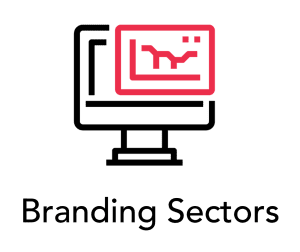A brand is the most valuable asset to a professional service firm. Developing a stronger brand is the most important task that a firm has to undertake. A professional services brand is best understood as a firm’s reputation and its visibility in the marketplace.
The strength of a brand can be measured as reputation into visibility. Brand development is the process of strengthening and creating a professional service brand.
For firms to develop their brand they can divide the process into three phases, first phase is getting the brand strategy right and aligned with the business objectives. Secondly, developing all the tools the firm will need to communicate the brand, such as the logo, tagline and website.
And finally, the most important phase of strengthening the newly developed and updated brand. The brand strategy is the plan how the firm and team will build, shape and grow the brand. It is an entire experience for the customers to have with the business.
The brand development strategy is how the firm goes about accomplishing these tasks. To make the task easier they can be broken down into 10- steps.
A 10-step Brand Development Strategy
- Consider the overall business strategy
A strong, well differentiated brand will make growing the firm much easier. The overall business strategy is the context for the brand development strategy, so that’s the place to start. If the company is clear about where they want to take the firm, the brand will help them get there.
- Identify the target clients
Research states that high growth; high profit firms are focused on having clearly defined target audience. The growth will be faster if the focus is narrower. The more diverse the target audience, the more diluted the firms marketing efforts will be.
- Research the target client group
Firms that conduct systematic research on their target client group grow faster and are more profitable. Further, firms that conduct research more frequently, at least once per quarter grow faster.
Research helps the firm understand the target client’s perspective and priorities, anticipate their wants and needs and put the message in a language that resonates with them.
It also communicates as to how the audiences view the firm’s strengths and current brand. As such, it dramatically minimalizes the marketing risk associated with brand development.
- Develop the brand positioning
A positioning statement is typically three to five sentences in length and captures the essence of the firms brand positioning. The statement should be grounded in reality, as the firm will have to deliver what they have promised. It must be a bit aspirational so the audiences have something to strive for.
- Develop the messaging strategy
The next step is a messaging strategy that translates the brand positioning statement into messages to deliver to the various target audiences. The firms target audiences typically include potential clients, potential employees, referral sources or other influencers and potential partnering opportunities to state a few of the usual suspects.
While the firm’s core brand positioning must be the same for all audiences, each audience group will be interested in a different aspect of it.
The messages to each audience group will emphasize the most essential points. Each audience will also have specific concerns that must be addressed whereas each will need different types of evidence to support the firm’s messages.
The messaging strategy should address all of these needs and wants. This is an important step in making the brand relevant to the firm’s target audiences.
- Develop a name, logo and tagline
Most firms do not require a name change, but if it is a new firm, or are undergoing a merger or are burdened with a name that no longer suits the firms positioning, a name change is in order.
Even if a firm decides not to change their name, a new logo and tagline may make sense to better support the brand’s positioning. It is important to remember that the name, logo and tagline are no the brand.
They are a part of the brand identity, the ways to communicate or symbolize the brand. A firm should not make the mistake of showing their new logo around internally to get a consensus.
The name, logo and tagline are not for the firm, they are for the marketplace and they should be the judge on how well they are communicated and not how many the partners like them.
- Develop the content marketing strategy
Content marketing is well suited to professional services firms in today’s internet age. It does all the things that traditional marketing does, but it does them with more efficiency.
It uses valuable educational and informative content to attract, nurture and qualify prospects. It is important to remember that the brand strength is driven by both reputation and visibility.
Increasing visibility alone, without strengthening the firm’s reputation, is rarely successful. That’s why traditional awareness building advertising, or sponsorship so often yields unsatisfactory results.
On the other hand, content marketing increases both reputation and visibility at the same time. It is also the perfect way to make the brand relevant to the target audiences.
- Develop the website
A firm’s website is the single most important brand development tool. It is the place where all the audiences turn to and learn what the brand is doing, how they do it and who the clients are.
Prospective clients are not likely to choose the firm solely based on the website but they may well rule it out if the website gives the wrong message. Furthermore the website will be the home to the brand’s valuable content.
That content will become the focus of the firm’s search engine optimization efforts so that the prospects, potential employees and referral sources will be able to find the brand and learn about the firm.
Online content is central to any modern brand development strategy. Professional services websites are available in two varieties, the first being a branding site.
A branding site tells a brand story and conveys who they are, who they serve, and what they do. In short it conveys the brand message. The other variety does the above along with generating and nurturing potential new clients, and it is known as high performance websites.
- Build marketing toolkit
The next step in the process is to build out the remainder of the brand’s marketing toolkit. This might include one-page sales sheets that describe the core services offering or key markets served by the brand. In addition, it may also include a brief pitch deck that overviews the firm or key offerings and an e-brochure about the firm.
Increasingly these marketing toolkits include videos. Popular video topics such as firm’s overview, case studies or meet the partner videos. Key services offering are very useful to the brand. If prepared properly, these tools serve not only a business development function but also are important for brand development.
- Implement, track and adjust
The final step in the brand development process is the most important. A winning brand development strategy does not do much good if it is never implemented. A solid strategy is developed and started will all the good intentions the firm can muster but then realties intervenes.
People get busy with client work and brand development tasks gets put off and forgotten.
That is why tracking is very important and is strongly recommended for both implementations of the plan as well as the results. By tracking the entire process the firm can make sure they are drawing the right conclusions and making the right adjustments.
When a brand or company has created a successful brand strategy, customers know who the company is and what they do without being reminded. Companies as large as Apple and Coca Cola have successfully implemented brand strategies.
Without a brand strategy, firms are making wild guesses and assumptions, which lead to brand inconsistencies.
The brand strategy gives the business a spine to build its branding efforts around as well as it helps to guide and inform the way the brand communicates.
Having a brand strategy for the business should be at the top of the priority list as excessive competition makes it harder for businesses to stand out hence having a strategy is necessary. Since it is challenging to leave a mark, investing in a sound brand development plan can resolve the firm’s issues.
A brand identity could prove to be valuable asset in the long run, therefore it is important for a business to follow the 10-step brand development plan that could set the firm for success.
However the firm is not completely done even after implementing and tracking the brand development process. Building a brand is a life-long process and requires continues dedication. It is important to carefully develop a message and ensure that it aligns with the brand’s values and goals.
Also, becoming the brand’s advocate and getting the employees in on it as well is essential for strategy to be a success. Spread the word about the brand and ensure that every aspect of that message paints a brilliant picture in the minds of the brands target audience.












